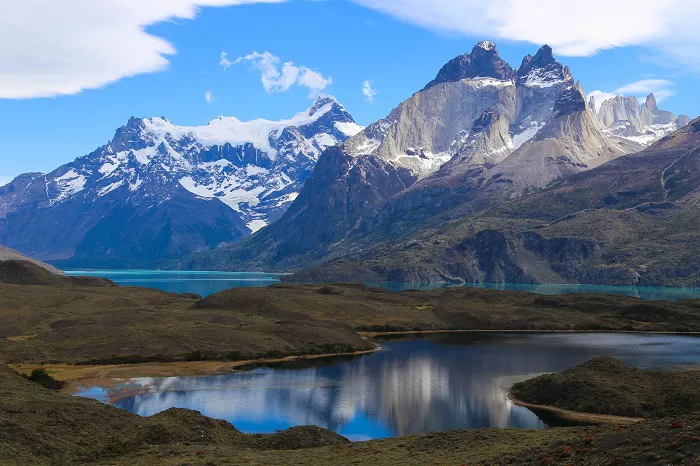Low clouds drift over the horn-like peaks of the Cuernos del Paine as visitors journey through Chile’s Torres del Paine National Park en route to the formidable Grey Glacier. Aboard the catamaran Lady Grey 3, the approach to this icy monolith resembles a painting slowly revealing itself, each stroke adding depth with varying shades of blue.
Standing on deck, Tierra Patagonia guide Jonathan Arancibia, cheeks flushed from the chill, leans into the wind to brief the group. “This glacier is part of the Southern Patagonian Ice Field, which spans approximately 13,000 square kilometres. It is the third-largest freshwater reserve in the world, following Antarctica and Greenland,” Arancibia explains, gesturing toward the towering ice slabs that loom above Grey Lake.
The journey began in the early morning from Tierra Patagonia, a luxury lodge perched beside Lake Sarmiento. As the sky remained cloaked in a pre-dawn veil, the group navigated a winding route past the dramatic, jagged silhouettes of the Torres del Paine mountains to reach the lake’s edge.
Jonathan, a veteran guide with 15 years of experience across South America, emphasizes the significance of witnessing glaciers up close. “Glaciers have shaped this land, carving out U-shaped valleys and defining the region’s unique geological features,” he notes.
Despite holding a degree in North American literature rather than geology, Arancibia expresses a deep appreciation for the glaciers. “They provide a visual narrative that helps us understand the geology. It’s like nature’s cathedral — every detail sculpted over millennia,” he says with a smile.
As spring breathes its crisp air across Chile, passengers retreat to the warmth of the boat’s cabin while Jonathan shares tales of extremophiles—organisms that endure the glacier’s harsh conditions. Among them is the so-called Patagonian dragon, a microbe thriving in one of Earth’s most inhospitable environments.
Back at Tierra Patagonia, luxury contrasts starkly with the rugged surroundings. The lodge, part of the Baillie Lodges collection and designed by Chilean architect Cazu Zegers, mirrors the undulating contours of Lake Sarmiento. Its 40 rooms, clad in lenga wood, shimmer like silver under the Andean light, appearing from above as a serpent nestled into the landscape.
Inside, the structure’s flowing architecture connects suites with communal lounges and dining spaces framed by floor-to-ceiling windows, offering uninterrupted views of the surrounding wilderness. Wildlife is frequently spotted from within, including guanacos grazing on nearby plains and the occasional culpeo fox sheltering beneath brush.
Guided excursions range from hikes to the Base of the Towers to wildlife treks along the Ascensio River. Though pumas inhabit the region, sightings are elusive. For many, the highlight is a horseback ride from Estancia Lazo, a working ranch on Lake Sarmiento’s southern shore.
Here, local baqueanos (Chilean gauchos) like Francisco “Pancho” Ramos lead the way. Dressed in traditional attire—berets, wide trousers, and knee-high boots—the horsemen embody the spirit of Patagonian life. Accompanied by equestrian guide Hebe Webber, the ride offers sweeping views of lenga forests and the Paine Massif’s snowy granite peaks.
“This is a way of life,” Webber explains. “The baqueano live in harmony with the land. The mountains aren’t just scenery—they’re part of their identity.”
Though some visitors may not leave as dedicated horse lovers or microbe enthusiasts, many depart with a newfound reverence for Chile’s southern reaches. As night falls over Torres del Paine, stars scatter across the sky in dazzling display. For some, the experience transforms into something deeper: a love affair with Chile itself.


